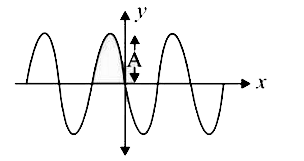A wave is represente by y=Asin2(kx−ωt+ϕ). The amplitude and wavelength of wave is given by
2A,2πk
A,2πk
A2,2πk
A2,πk
The correct Answer is:D
To solve the problem, we need to analyze the wave equation given as y=Asin2(kx−ωt+ϕ) and determine its amplitude and wavelength.
Step 1: Rewrite the Wave Equation
We start with the equation:
y=Asin2(kx−ωt+ϕ)
Using the trigonometric identity for sin2, we can rewrite sin2θ as:
sin2θ=1−cos(2θ)2
Here, θ=kx−ωt+ϕ. Therefore, we can express sin2(kx−ωt+ϕ) as:
sin2(kx−ωt+ϕ)=1−cos(2(kx−ωt+ϕ))2
Step 2: Substitute Back into the Equation
Substituting this back into the wave equation gives:
y=A(1−cos(2(kx−ωt+ϕ))2)
Simplifying this, we get:
y=A2−A2cos(2(kx−ωt+ϕ))
Step 3: Identify Amplitude
In the rewritten equation, the term −A2cos(2(kx−ωt+ϕ)) indicates that the amplitude of the wave is the coefficient of the cosine term. Therefore, the amplitude Awave is:
Awave=A2
Step 4: Determine the Wavelength
The wave number k is related to the wavelength λ by the formula:
k=2πλ
In our case, the argument of the cosine function is 2(kx−ωt+ϕ), which implies that the wave number is 2k. Therefore, we can express the wavelength as:
2k=2πλ⟹λ=2π2k=πk
Final Results
Thus, the amplitude and wavelength of the wave are:
- Amplitude: A2
- Wavelength: πk
Summary of Answers
- Amplitude: A2
- Wavelength: πk
We start with the equation:
y=Asin2(kx−ωt+ϕ)
Using the trigonometric identity for sin2, we can rewrite sin2θ as:
sin2θ=1−cos(2θ)2
Here, θ=kx−ωt+ϕ. Therefore, we can express sin2(kx−ωt+ϕ) as:
sin2(kx−ωt+ϕ)=1−cos(2(kx−ωt+ϕ))2
Substituting this back into the wave equation gives:
y=A(1−cos(2(kx−ωt+ϕ))2)
Simplifying this, we get:
y=A2−A2cos(2(kx−ωt+ϕ))
In the rewritten equation, the term −A2cos(2(kx−ωt+ϕ)) indicates that the amplitude of the wave is the coefficient of the cosine term. Therefore, the amplitude Awave is:
Awave=A2
The wave number k is related to the wavelength λ by the formula:
k=2πλ
In our case, the argument of the cosine function is 2(kx−ωt+ϕ), which implies that the wave number is 2k. Therefore, we can express the wavelength as:
2k=2πλ⟹λ=2π2k=πk
Thus, the amplitude and wavelength of the wave are:
- Amplitude: A2
- Wavelength: πk
- Amplitude: A2
- Wavelength: πk
Topper's Solved these Questions
Similar Questions
A progressive wave travelling along the positive x-direction is represented by y(x,t)=Asin(kx−ωt+ϕ). Its snapshot at t=0 is given in the figure.
For this wave, the phase is:

View SolutionTwo waves represented by y=asin(ωt−kx) and y=acos(ωt−kx) are superposed. The resultant wave will have an amplitude.
View Solution
Knowledge Check
A transverse wave is represented by y=Asin(ωt−kx). For what value of the wavelength is the wave velocity equal to the maximum particle velocity?
AπA2BπAC2πADAA transverse wave is represented by y=Asin(ωt−kx). For what value of the wavelength is the wave velocity equal to the maximum particle velocity?
AπA/2BπAC2πADAA transverse wave is represented by y=Asin(ωt−kx).The wave velocity and the maximum particle velocity will be equal at the wavelength of
AπA/2BπAC2πADA
In a stationary wave represented by y=asinωtcoskx, amplitude of the component progerssive wave is
View SolutionIn a stationary wave represented by y=asinωtcoskx, amplitude of the component progerssive wave is
View SolutionA sinusoidal wave is given by y=A sin (kx-ωt). The ratio of its maximum particle velocity to wave velocity is
View SolutionThe equation of a standing wave in a string fixed at both its ends is given as y=2A sin kx cos ωt. The amplitude and frequency of a particle vibrating at the point of string midway between a node and an antinode is
View SolutionA travelling wave represented by
y=Asin(ωt−kx)
is superimposed on another wave represented by
y=Asin(ωt+kx). The resultant is
View Solution
